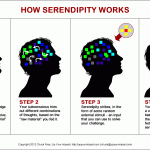 There is an increasing appreciation for the power of serendipity in promoting and supporting innovation. I’ve written before about the tremendous power of recombination, and how much innovation is taking ideas from elsewhere and building on them or combining them with others.
There is an increasing appreciation for the power of serendipity in promoting and supporting innovation. I’ve written before about the tremendous power of recombination, and how much innovation is taking ideas from elsewhere and building on them or combining them with others.
The question then becomes how you go about finding those people. There have been two divergent approaches in recent years. The likes of open innovation has attempted to largely bring people together virtually, with locational or organizational ties irrelevant.
We’ve also seen however the rise in clusters, with most major cities around the world attempting to foster a cluster of some kind or other. Indeed, I’ve written a bit about the recent digital accelerator that’s opened in London in recent months.
Regardless of whether you look to network online or face to face however, I think one thing that is undoubtedly true is that networking remains key to successful innovation.
Take the classic study conducted by Duncan Watts and Gueorgi Kossinets a few years ago into social networks and how friendships form.
They found that around about 45 percent of our new connections form because we both have mutual friends or connections. A further 41 percent of new connections form when the mutual connections were combined with a shared context (ie both hanging out on Galaxy Zoo or trying to build a digital start-up).
Indeed, they found that when neither of these conditions were present, they were roughly 30 times less likely to connect up than people who had either a shared connection or a shared context.
It underlines the importance, for me at least, of mining in both the virtual and physical worlds for contacts and ideas. It’s a notion underlined by some recent research conducted by Roopa Unnikrishnan.
She suggests that rather than looking to locate people physically together in one place, it’s more important to enable virtual networks to form.
She goes on to suggest that the most innovative people and organizations have an incredibly wide net that they cast out in the hunt for ideas and insights. It means going beyond physical hotbeds of creativity towards something much more virtual.
It’s easy to fall into the trap of thinking serendipity happens by chance, but just as Richard Wiseman has shown how ‘luck’ is more down to how you live, so I believe is serendipity.
Exactly, you have to put yourself out there for 'luck' to strike.
We don’t see those approaches as divergent, but mutually reinforcing. Our technology enables the online networking but our community building approach supports it with face to face, often geographical, real world activities. We call it ‘engineering serendipity’!v:-)